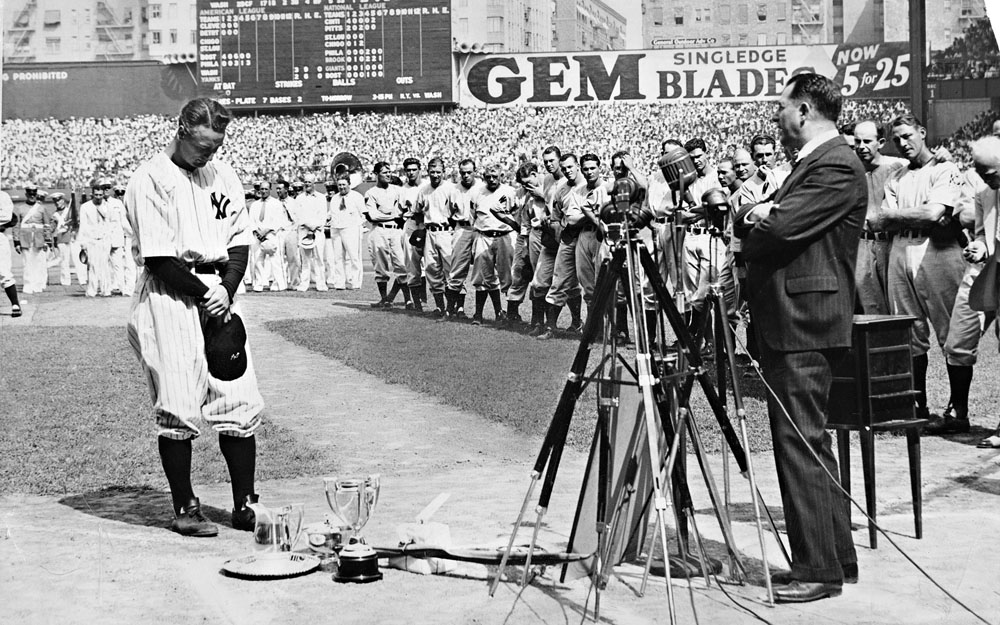The New York Times, 19 April 2005
When my patient Jackie, who had incurable lung cancer, came to my office, she would regale me with her latest physical accomplishments. “I’m doing great, doctor, right?” she would ask.
As I answered this and other questions from her, I struggled to balance the reality of Jackie’s prognosis with a hopeful outlook. Now a new book describes another doctor who did the same for his patient, who had a fatal neurological disease. That patient was Lou Gehrig.
The Hippocratic Oath and other ethical codes that guided the medical profession for centuries generally omitted the notion of truth-telling. In fact, one of Hippocrates’s injunctions, to keep the sick from harm and injustice, encouraged the opposite behavior, deception.
Serious illnesses, after all, were bad news. While doctors could give pain medications and other palliatives to patients with widespread cancer or tuberculosis, no cures existed.
Faced with such situations, physicians often actively misled their patients, using euphemisms like “tumor” or “growth” when describing cancer. These doctors believed that the unvarnished truth would not only be emotionally hurtful, but it would lead patients to give up and thus die sooner.
It was exactly this type of paternalism that patients rejected beginning in the 1970’s. When I teach bioethics to medical students, I tell them that patients must be told the truth about their terminal illnesses.
So, in 1999, I told Jackie she had lung cancer. Chemotherapy could prolong her life, I explained, but the disease was fatal.
Jackie heard me loud and clear. But as she began her treatment and felt better, she increasingly focused on the positive. For one thing, she rarely used the word “cancer” during our appointments.
“I’m glad we caught this thing in time,” she often told me. At other times, she said, “I’m going to beat this.”
I knew that Jackie was in denial. And some degree of denial is surely advisable in such situations. So I was careful not to puncture Jackie’s balloon. I reveled in her successes, which included running up and down the stairs of her apartment building and helping to raise a niece, who was sharing her apartment.
When Jackie’s claims became too fanciful, I gently admonished her, reminding her that the odds were stacked heavily against her. But I avoided any direct statements discouraging her optimism.
When the illness of the famed Yankee first baseman Lou Gehrig was diagnosed as amyotrophic lateral sclerosis, or A.L.S., at the Mayo Clinic in June 1939, his prognosis was similar to that of Jackie: a few years at best. Gehrig’s doctors told him the exact name of his disease, which they knew to be uniformly fatal.
But as described in a biography of Gehrig, “Luckiest Man,” by Jonathan Eig, a journalist, the story was more complicated. Mr. Eig unearthed a series of letters exchanged between Gehrig and his Mayo Clinic physician, Dr. Paul O’Leary, that revealed a more optimistic spin on Gehrig’s disease. In the summer of 1939, having begun treatment with a series of vitamins, Gehrig told Dr. O’ Leary that he was improving.
Then, in December 1939, Gehrig met a New York musician, Al Reiser, who had seemingly recovered from A.L.S. after receiving similar pills and injections.
“Have you ever had any such experience as Reiser’s with any of your patients?” the ballplayer excitedly asked Dr. O’Leary.
The doctor chose to deceive his patient. “Al Reiser,” he wrote to Gehrig, “is just one of a group that have been improved and I trust that in seeing him you have been reassured that there is a damn good probability that you will do likewise.”
Dr. O’Leary, Mr. Eig notes, knew quite well that Reiser must have had a different type of paralysis.
As Gehrig deteriorated, he frequently entreated Dr. O’Leary to tell him the truth. In a letter in March 1940, he asked: “What is your conclusion? And honestly, please.”
But Dr. O’ Leary continued to stress the positive. He did so with the full cooperation of Gehrig’s wife, Eleanor, whose separate correspondence with the doctor asked him to “lie like mad” to maintain a “thread of hope.” Gehrig died in 1941.
What Dr. O’Leary did 65 years ago, ignoring his patient’s request for the truth, is clearly unacceptable today. But doctors continue to walk a fine line between being frank and encouraging.
After more than two years of reasonably good survival from her lung cancer, Jackie finally began to deteriorate. I asked her if she would like to be resuscitated when her heart stopped, and she said no. She knew she was dying.
Had I done a good job with Jackie? I took some solace from the fact that as death approached, she did not appear to regret her earlier hopeful predictions. Nor did she admonish me for having been less than completely forthcoming. In Jackie’s case, it seemed, Eleanor Gehrig’s “thread of hope” had been worth preserving.
